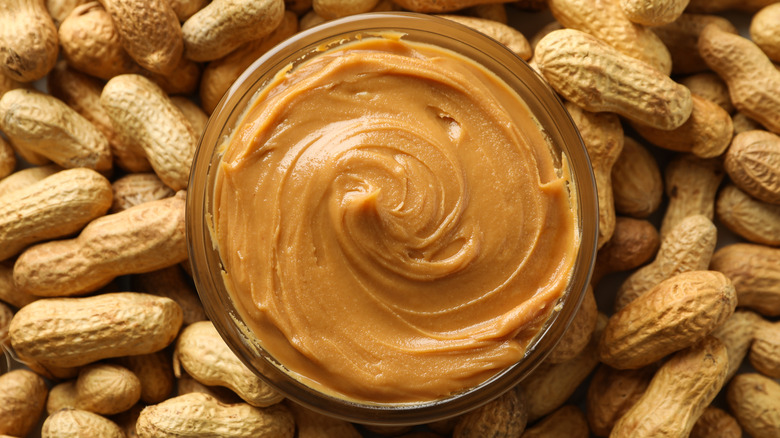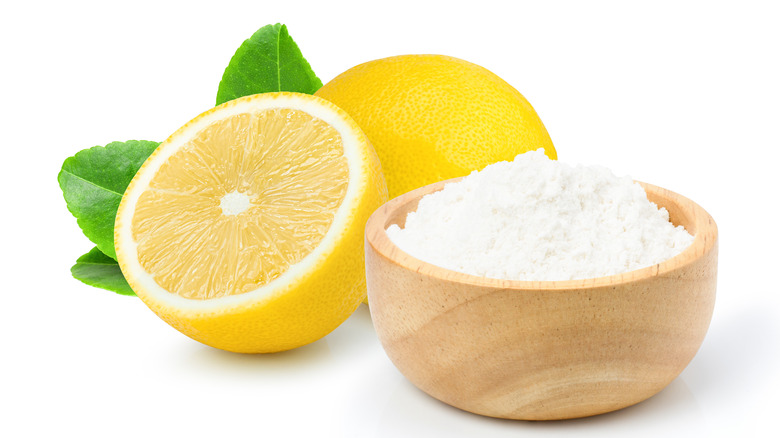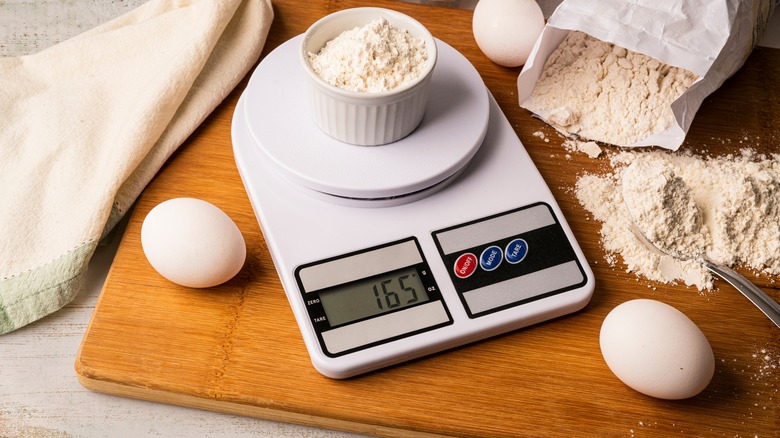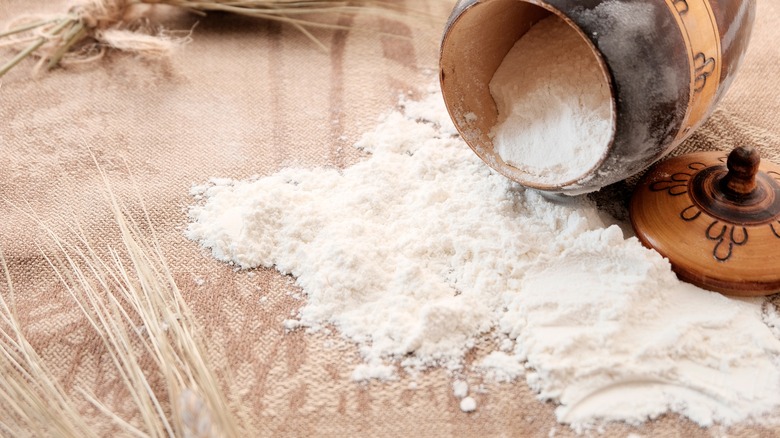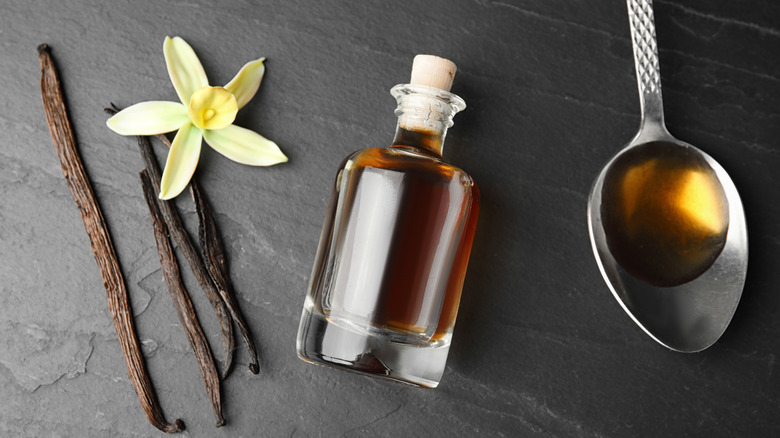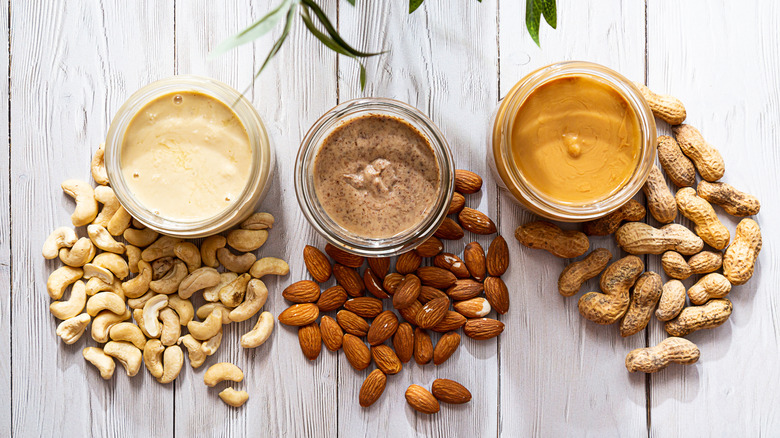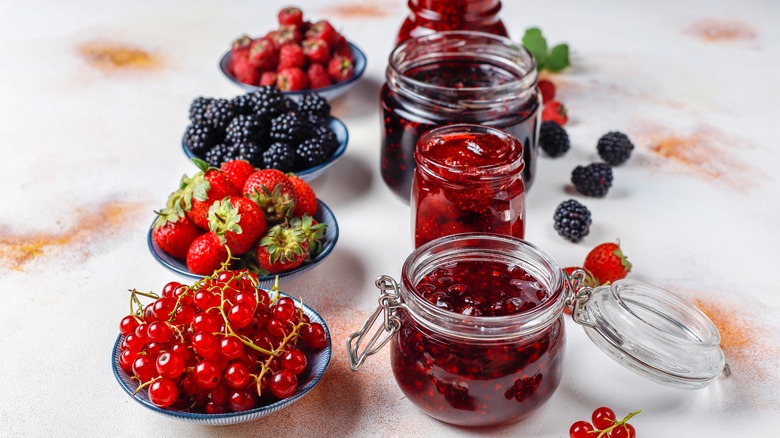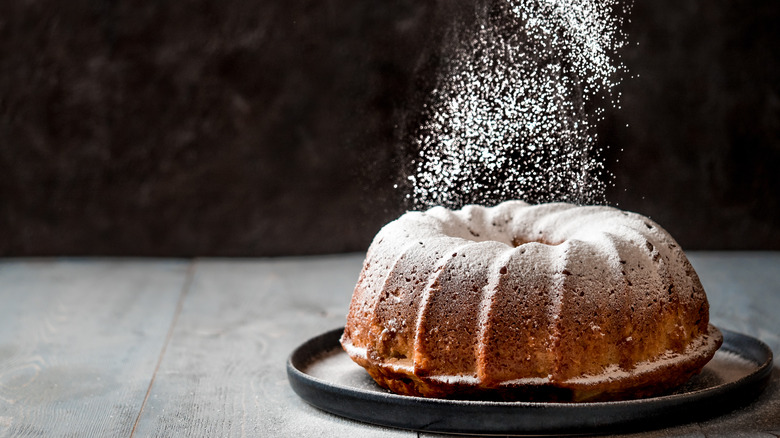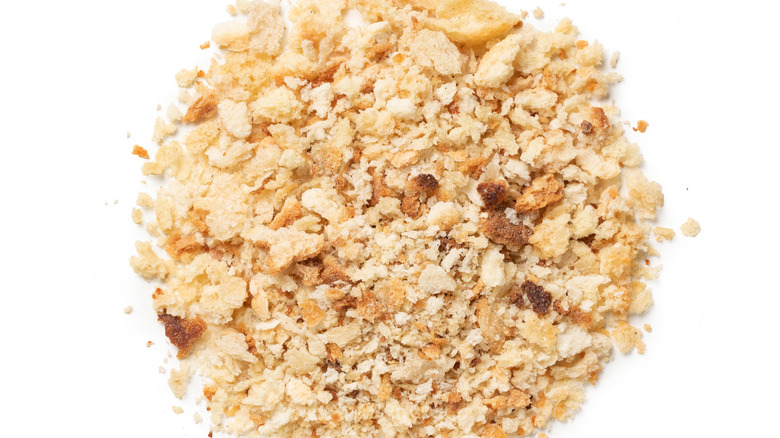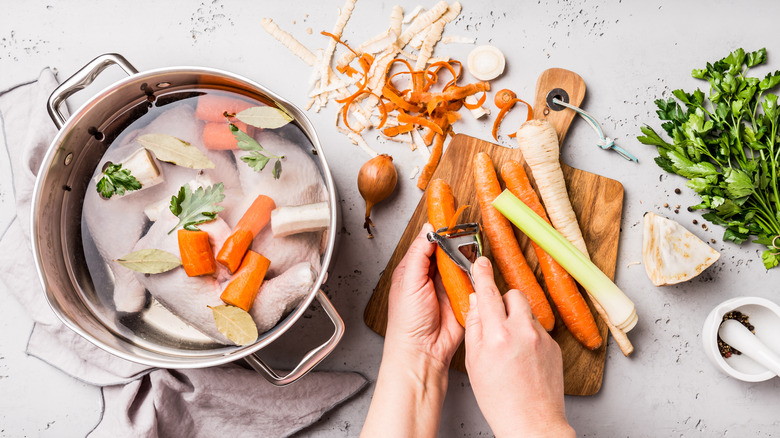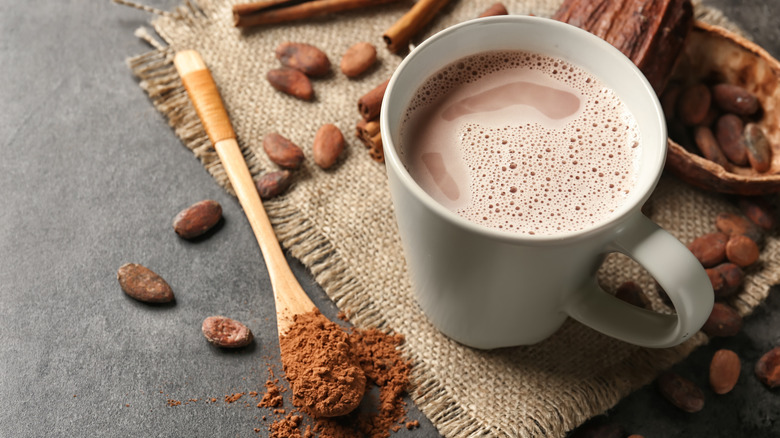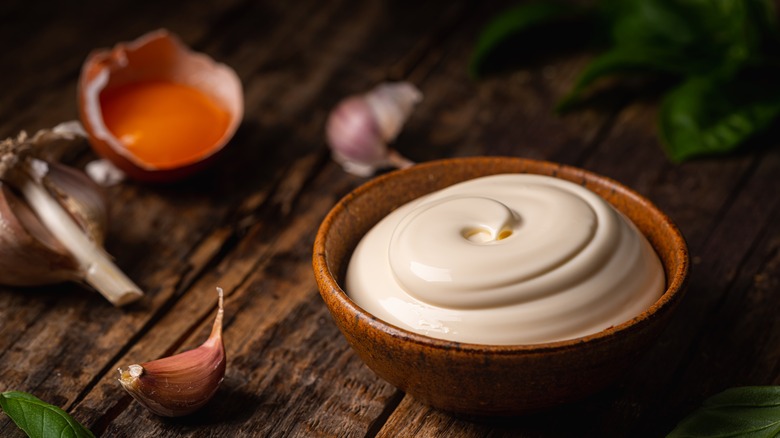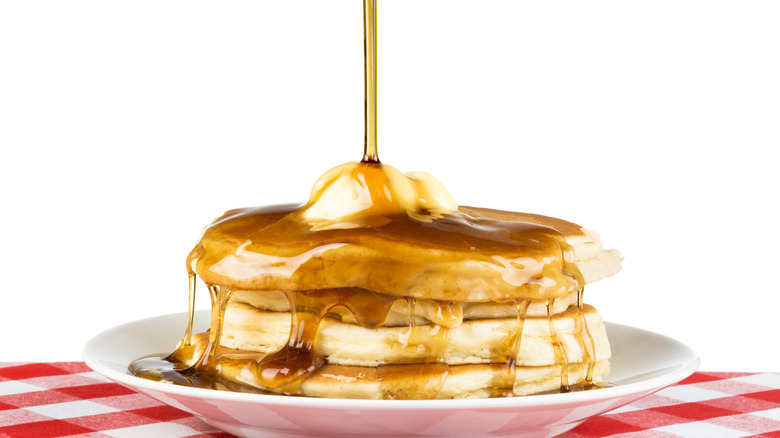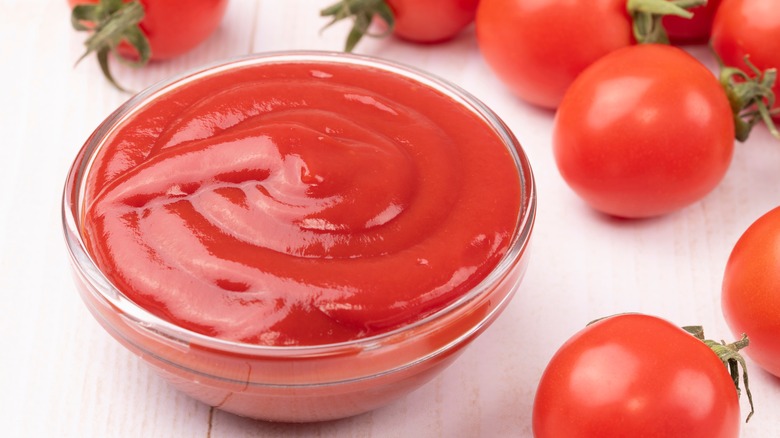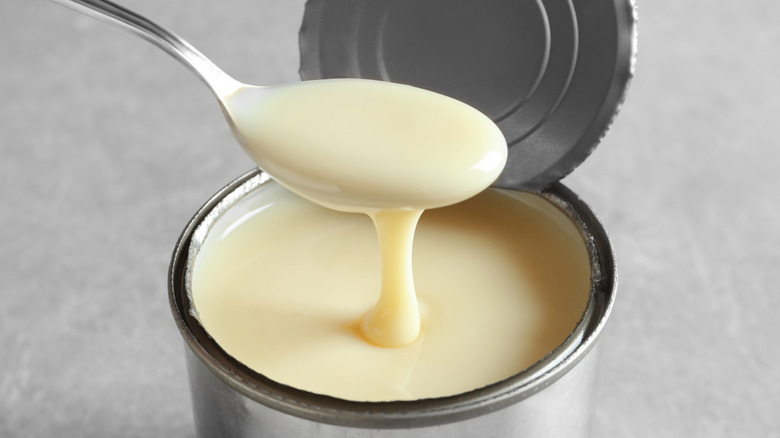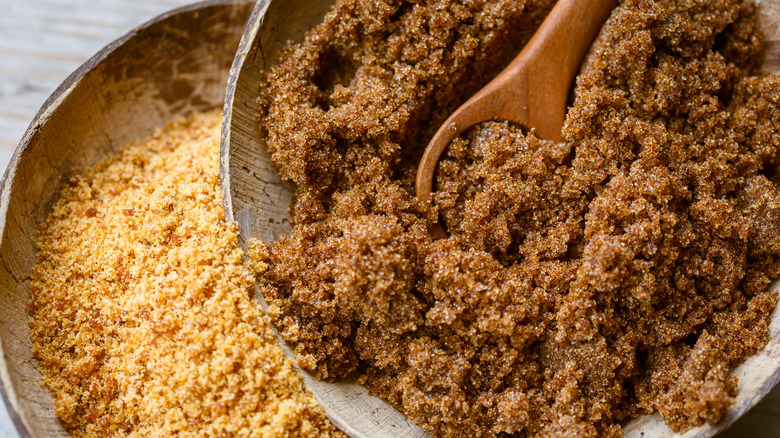Pantry Items You Can Make From Scratch
With easy access to common pantry staples at grocery stores throughout the world, one might wonder what's the point of making ingredients like baking powder or brown sugar at home. But there are times where you may encounter an intriguing new recipe or develop a craving for an old one — only to open your cupboards and discover you've run out of a crucial ingredient. After all, we are only human, and our grocery list writing skills are not infallible. Knowing how to make common pantry items can save you an extra trip to the grocery store, allowing you to get that chocolate chip cookie you've been hankering for into your mouth sooner.
Additionally, Americans are walking out of the supermarkets with higher bills, as grocery prices rose an eye-watering 12% in 2022 (via CNN). If you cook often, or have a big family to feed, buying large quantities of items like peanut butter or chicken stock can eat into your monthly budget. By making homemade versions of certain cooking staples, you can help trim down your grocery bills and also have more control over what goes into your food. Convinced yet? Here are a number of pantry items that you can make at home.
Baking powder
Many baked goods, such as cakes and biscuits, owe their light and fluffy texture to the addition of baking powder. It is not to be confused with baking soda — which is also used to give rise to cakes and pastries — and should not be used interchangeably. Instead, baking soda is used to make baking powder.
Baking powder is a mixture of baking soda, an acid, and an anti-caking agent. Food Network explains that when baking powder is mixed into a batter or dough, water activates the acid — which in turn reacts with the baking soda to produce gasses that leaven the product. To make baking powder, simply mix cream of tartar with baking soda and cornstarch.
However, there are differences to note when using homemade baking powder. According to Martha Stewart, most commercial baking powders are double-acting and react twice during the baking process: first when mixed with a liquid and a second time when exposed to the oven's high temperatures. This second reaction is due to the use of chemicals like sodium aluminum sulfate in store-bought baking powders. Homemade baking powder, on the other hand, is single-acting. This means that it is less likely to impart a metallic flavor to your bakes, but it's also less effective if you leave your dough or batter out for too long before baking. When using the homemade version, it is best to bake your goods as soon as they are mixed.
Cake flour
As the name suggests, cake flour is best used to make cakes. A type of flour with a low protein content, it produces a lighter and more tender crumb in cakes. King Arthur Baking explains that this is due to the lower percentage of protein in cake flour, which results in less gluten development and a product that is less chewy and tough in texture.
To make cake flour, simply add cornstarch to your all-purpose flour. According to Fine Dining Lovers, cornstarch is a flavorless and colorless powder made from the endosperm of the corn kernel, which does not contain protein and is gluten free. This makes it the perfect ingredient to add to all-purpose flour in order to lower its protein content without altering the flavor or appearance of the recipe. To get cake flour, sift all-purpose flour together with a small amount of cornstarch.
Self-rising flour
Another type of flour with a straightforward name, self-rising flour does exactly what it advertises — it allows baked goods to rise without the need to mix in additional leaveners. Invented in the 1800s as a way to allow British sailors to have access to fresh bread on long voyages without the use of yeast, self-rising flour is a combination of flour, baking powder, and salt (via Bob's Red Mill). These days, it is especially common in Southern recipes, such as biscuits and cornbread.
It is simple to make your own self-rising flour — combine all-purpose flour, baking powder, and salt. However, Food Network notes that most commercial self-rising flour brands, such as the popular White Lily brand, are made with lower-protein flours. To achieve tender and delicate results that are more similar to those made with store-bought self-rising flour, use half all-purpose flour and half cake flour with the other ingredients instead.
Vanilla extract
We've all heard the expression "vanilla" to describe something as plain or boring, but real vanilla is far from boring. According to HuffPost, it is the second most expensive spice in the world, behind only saffron, the famous thread-like stigmas harvested from a crocus flower. Vanilla beans also come from a flower — an orchid to be exact. And the labor-intensive process of hand-pollinating the flowers and the unpredictable weather conditions of the tropical locations where vanilla is grown are reasons for its high price.
If you love the sweet, creamy flavor of true vanilla, you might want to stop buying those pricey, tiny bottles of vanilla extract at the store. To make your own, you need three things: vanilla beans, alcohol, and patience. In a jar or airtight bottle, cover the vanilla beans in neutral-flavored alcohol and wait for three to six months. To ensure better infusion, make sure to split your vanilla beans in half and expose the tiny seeds, aka the vanilla caviar, to the alcohol.
If you've scraped out the vanilla caviar to use in a different recipe, don't throw the empty pods out! You can use them to make vanilla extract as well. However, King Arthur Baking notes that without the seeds, the infusion process will take a longer time to impart the same level of flavor.
Nut butter
Gone are the days when peanut butter was the only option of nut butter at the grocery store. A range of other nut butters have cropped up — almond, macadamia, cashew, and even seed butters made from pumpkin or sunflower seeds.
While this newfound variety available on the market is exciting, making your own nut butter at home is equally impressive. This way, you get to make it exactly how you'd like it. Salted or unsalted? Sweetened with honey or maple syrup or left unadulterated? Perhaps a blend of macadamia nuts and sunflower seeds might be your new favorite thing on toast. And the best part of it is, you can make nut butter for a fraction of the price of the commercially made product.
Simply process your nuts and seeds in a food processor or a high-speed blender until the paste comes to your preferred consistency and season with salt, spices, or sweetener, or leave it plain. For a better flavor, MasterClass recommends toasting the nuts and allowing them to cool before blending. However, due to the lack of added preservatives, do not expect homemade nut butters to have the same shelf life as their store-bought versions. Make smaller batches of nut butter to ensure they stay fresh, and remember the general ratio where 2 cups of nuts yield 1 cup of nut butter (per Cooking Light).
Jam
With its vibrant colors and bright flavor, jam captures the bounty of summer in a jar. Originally used to preserve fruit when freezing food was not an option, jam is made of fresh fruit cooked with high amounts of sugar, which prevents the growth of microbes (via The Guardian). These days, with frozen fruit and imported food, jam is made more for the pleasure of eating it.
Although the sugar in jam prevents spoilage and gives it a spreadable consistency, some of us may balk at the amount of refined sugar in jam. Fortunately, methods of making homemade jam with less sugar exist. And to (metaphorically) sweeten the deal, they are easy and quick, omitting the long boiling process used to make traditional jams.
There is freezer jam, where chunks of gently crushed fruit are mixed with sugar, lemon juice, and no-cook pectin and stored in the freezer. NPR explains another benefit of making freezer jam — since it does not involve cooking, the end result is a jam that tastes more vibrant and closer to fresh fruit than cooked jams. Alternatively, make chia seed jam, where juicy fruit like berries are heated and mashed until they start to break down and then thickened by the addition of chia seeds instead of sugar. However, these methods do not result in the same shelf life as traditional jams, and your jam should be kept frozen or eaten within a week to prevent spoilage.
Powdered sugar
There are days when whipping up some frosting for a cake seems like a little too much work. Here, powdered sugar comes to the rescue. By mixing it with a flavorful liquid like milk or lemon juice, you can make an easy glaze to drizzle on your cake, or, even better, you can dust the cake with powdered sugar and call it a day. It also features in many other recipes, such as macarons and fondant.
Powdered sugar is simply regular sugar that has been ground finely, allowing it to dissolve in liquid more easily at room temperature. If it's something that you do not keep in your pantry, making it at home is easy enough. Just grind regular granulated sugar in a food processor or high-speed blender until it becomes a fine powder. Good Housekeeping warns not to continually process the sugar for more than a minute, as the machine produces heat that will melt the sugar. Sift out any large pieces, and combine the powdered sugar with a small amount of cornstarch.
According to Martha Stewart, powdered sugar with added starch is confectioner's sugar, although the two terms are used interchangeably. If you are particularly sensitive to the chalk-like texture and taste that cornstarch adds to the sugar, feel free to omit it. The starch is added to prevent the sugar from clumping over time and is not necessary if you are using the powdered sugar immediately or are sifting it before use.
Breadcrumbs
According to Statista, bread is one of the most common foods that go to waste in the U.S., with 32% of the bread produced ending up in the bin. Reduce food waste by transforming your stale bread into breadcrumbs, a pantry staple that has its uses in countless dishes, including meatballs, schnitzels, and mac and cheese.
BBC Good Food explains that breadcrumbs come in a few different forms. Fresh breadcrumbs are made by simply processing bread into tiny pieces in a food processor or blender and are used mostly as a binder in items like meatballs and crab cakes. Dried breadcrumbs, on the other hand, are made with bread that has been dried out in a low oven until golden, and they're especially useful for coating ingredients before deep frying or to add a crunch on baked dishes. Panko crumbs are lighter, airy crumbs made from crustless white bread that has been dried in a low oven and are traditionally used in deep-fried Japanese dishes like tonkatsu.
No matter the type of breadcrumbs you've decided to make, you can always have some on hand by storing them in the freezer in an airtight container or bag. Better Homes & Gardens states a shelf life of four months, leaving you plenty of time to experiment with new recipes that use this pantry staple.
Stock
Most traditional stocks call for roasted bones and mirepoix — a mix of carrots, celery, and onions — to contribute flavor to this base cooking liquid (per MasterClass). However, if you are less particular about keeping to tradition, you can make your own homemade stocks with leftover ingredients that would have ended up in the bin at the end of the day.
Leftover bones from a roast chicken, leek greens, carrot peelings, and broccoli stems can be thrown in a large pot, covered in cold water, and simmered for several hours to produce a flavorful, nutritious chicken stock that tastes better than most store-bought options. BBC Good Food notes that going the DIY route allows you complete control over what goes into your stock while costing effectively nothing.
Alternatively, you can also purchase bones or offcuts like feet and necks at the butcher for a cheap price in order to make larger batches of stock. For vegetable stock, save the trimmings of vegetables from your everyday cooking by storing and freezing them in resealable bags until you have a nice amount of vegetable scraps to make stock out of.
Hot cocoa mix
It might sound like a cliché, but nothing evokes nostalgia like cold winter nights and hot cocoa. But while Swiss Miss may have been a childhood staple, the flavor of homemade cocoa far surpasses the vaguely chocolatey products of store-bought versions.
Hot cocoa, often mistaken to be the same as hot chocolate, is made up of cocoa powder, sugar, and milk. Hot chocolate, on the other hand, is made with actual chocolate melted in milk or water. MasterClass explains that hot cocoa is of a thinner, lighter consistency and has a sweeter flavor, while hot chocolate is more rich and thicker in texture.
Making your own instant hot cocoa mix is a matter of combining Dutch-processed cocoa powder, powdered sugar, milk powder, and salt. While you can tweak the amounts of each ingredient to suit your tastes, start with a basic ratio of 1 cup of cocoa powder to 2 cups of powdered sugar and 2½ cups of milk powder. Customize the flavor by adding spices like cinnamon, or take a cue from Alton Brown and toast the milk powder before adding it to your cocoa mix — this creates notes of caramel and malt and brings your hot cocoa to another level.
Mayonnaise
The people of America have spoken, and they have declared mayonnaise to be the number-one condiment in the country, with sales reaching $164 million in 2021 (via Statista). It's clear that people throughout the U.S. love mayonnaise, and they are willing to pay for it. So why make mayonnaise at home? Despite the flavor that store-bought mayonnaise brings to sandwiches, potato salad, and deviled eggs, homemade mayo is on another level.
To make mayonnaise, oil is very slowly whisked into egg yolks and lemon juice (or vinegar). This forms an emulsion of oil and water, where miniscule droplets of oil are evenly distributed in water and stabilized by a compound in the egg yolks called lecithin, creating a thick and creamy texture (per The New York Times). While this process can sometimes be tricky and result in broken emulsions where the oil separates out of the mixture, there are a few tricks to prevent that from happening.
To ensure a stable emulsion, add in a small amount of water to the yolks before whisking in your oil, and add the oil drop by drop in the beginning. Adding mustard provides flavor and also helps create the emulsion. As mayonnaise contains raw egg yolk, it is best to use pasteurized eggs and consume within a week.
Pancake syrup
When it comes to eating pancakes or waffles, there are two types of people — Team Maple Syrup, and Team Pancake Syrup. You may think that the natural yet complex flavors of maple syrup, which is made from boiling and concentrating the sap of the maple tree, would be the more popular choice. However, in a survey of 1,000 Americans, over 70% of the respondents chose pancake syrup, a mixture of high fructose corn syrup, flavorings, and color, over maple syrup as their preferred accompaniment to pancakes (via The Washington Post).
If you, too, prefer the uncomplicated sweetness and affordable price of pancake syrup, you'll be glad to know that making it at home is even cheaper. Gently heat equal parts brown sugar, sugar, and water and mix until all the sugar has dissolved, and add maple flavoring to taste. Seeing as the homemade product is made up mostly of sugar, it is not necessarily a healthier option, but it allows you to avoid preservatives and coloring present in the store-bought versions.
Ketchup
While ketchup may have lost the title of America's number-one condiment to mayonnaise, the majority of Americans still enjoy ketchup. According to National Geographic, ketchup is found in 97% of American households. But while this tangy, vibrant condiment is a staple in the Western world, it has its origins in Southeast Asia, where it began as a fermented sauce made out of fish. In the 1700s, the British brought the idea of ketchup back home, and versions containing ingredients like walnuts, oysters, and mushrooms were common until 1876, when American Henry J. Heinz perfected the formulation for the company's iconic tomato ketchup (via History).
Making your own ketchup is not difficult. Bring canned or fresh tomatoes to a simmer with vinegar, brown sugar, and your choice of seasonings — usually fresh or powdered garlic and onions, and other spices like ground cloves, allspice and mustard. Cook the mixture until it has reduced and thickened, and then blend and strain it through a fine-mesh sieve. Serve with a heaping pile of fries, and store in the refrigerator for up to two weeks.
Sweetened condensed milk
Russian buttercream, key lime pie, and Thai iced tea. These are just a few sweet treats that owe their existence to sweetened condensed milk. Sweetened condensed milk is sometimes confused with another type of milk in a can — evaporated milk. Although these products are not interchangeable, they are very similar, as both are made by heating milk to remove at least 60% of its water content (via Food Network). The only difference between the two is that sweetened condensed milk has sugar added to it.
In fact, if you've run out of condensed milk, or are unwilling to clutter your pantry with too many cans, you can use evaporated milk to make sweetened condensed milk. You can do this by heating evaporated milk and white sugar in a saucepan, bringing it to a boil while whisking constantly until the milk has thickened. Alternatively, you can make sweetened condensed milk using fresh milk, or milk powder. You can heat milk and sugar on the stove, simmering the mixture until it reduces by almost half. This method can take up to an hour or so and requires frequent stirring. Using milk powder, on the other hand, is a much quicker process of blending hot water, milk powder, sugar, and a small amount of butter until smooth.
Brown sugar
When it comes to baking, brown sugar is often the secret weapon to add moistness and notes of toffee and caramel to your cookies and cakes. According to King Arthur Baking, brown sugar was originally made by leaving some of the naturally occurring molasses in the sugar during the refining process. However, these days, brown sugar sold at the grocery stores is made by adding molasses back to refined white sugar. The milder-flavored light brown sugar often used in cookies and banana bread contains about 3.5% molasses, while the more robust dark brown sugar found in gingerbread and spiced cakes has 6.5% (via Martha Stewart).
This means that brown sugar is actually incredibly easy to make at home. Keep a bottle of molasses in your pantry, and you will never need to buy brown sugar from the store. Simply add 1 tablespoon of molasses to every cup of white sugar for light brown sugar, and 2 tablespoons of molasses for dark brown sugar. King Arthur Baking even states that when making brown sugar at home for use in a recipe, there is no need to mix the molasses into the sugar — simply add both ingredients into your mixing bowl together.
